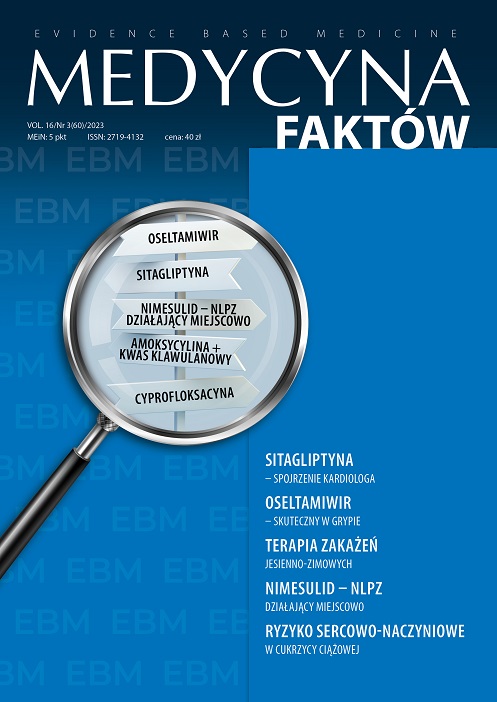Eight faces of ramipril, that is a therapeutic signpost for practicing physician A.D. 2023 Review article
Main Article Content
Abstract
According to current guidelines, when deciding to start antihypertensive treatment, the most important thing is to estimate the cardiovascular risk related to the degree of hypertension and the number and type of coexisting risk factors. Modern therapy involves not only achieving lasting normotension while maintaining good quality of life, but also correcting hemodynamic and metabolic disorders and, above all, prolonging life by reducing morbidity and mortality due to coronary events, heart failure and strokes. In most patients with hypertension and various comorbidities or a high risk of cardiovascular complications, the best choice is a drug that blocks the renin–angiotensin–aldosterone system. In coronary heart disease and other situations of high circulatory risk, ramipril plays a special role, as in addition to its hypotensive effect, it has outstanding cardio- and vasoprotective properties.
Article Details
Copyright © by Medical Education. All rights reserved.
References
2. Tykarski A, Filipiak KJ, Januszewicz A et al. Zasady postępowania w nadciśnieniu tętniczym – 2019 rok. Wytyczne Polskiego Towarzystwa Nadciśnienia Tętniczego. Nadciśnienie Tętnicze w Praktyce. 2019; 5(1): 1-84.
3. The Heart Outcome Prevention Evaluation Study Investigators. Effect of angiotensin-converting enzyme, ramipril on cardiovascular events in high-risk patients. N Engl J Med. 2000; 342: 145-53.
4. HOPE/HOPE-TOO Study Investigators. Long-term effects of ramipril on cardiovascular events and on diabetes: results of the HOPE study extension. Circulation. 2005; 112(9): 1339-46.
5. Heart Outcomes Prevention Evaluation Study Investigators. Effect of ramipril on cardiovascular and microvascular outcomes in people with diabetes mellitus: results of the HOPE study and MICRO-HOPE substudy. Lancet. 2000; 355: 253-9.
6. The DREAM Trial Investigators. Effect of ramipril on the incidence of diabetes. N Engl J Med. 2006; 355: 1551-62.
7. The Acute Infarction Ramipril Efficacy (AIRE) Study Investigators. Effect of ramipril on mortality and morbidity of survivors of acute myocardial infarction with clinical evidence of heart failure. Lancet. 1993; 342: 821-8.
8. Hall AS, Murray GD, Ball SG on behalf of the AIREX Study Investigators. Follow-up study of patients randomly allocated ramipril or placebo for heart failure after acute myocardial infarction: AIRE Extension (AIREX) Study. Lancet. 1997; 349: 1493-7.
9. Pfeffer MA, Greaves SC, Arnold JM et al. Early versus delayed angiotensin-converting enzyme inhibition therapy in acute myocardial infarction. The healing and early afterload reducing therapy trial. Circulation. 1997; 95(12): 2643-51.
10. Kjoller-Hansen L, Steffensen R, Grande P. The Angiotensin-converting Enzyme Inhibition Post Revascularization Study (APRES). J Am Coll Cardiol. 2000; 35(4): 881-8.
11. Lièvre M, Guéret P, Gayet C et al. Ramipril-induced regression of left ventricular hypertrophy in treated hypertensive individuals. HYCAR Study Group. Hypertension. 1995; 25(1): 92-7.
12. Agabiti-Rosei E, Ambrosioni E, Dal Palu C et al. ACE inhibitor ramipril is more effective than the beta-blocker atenolol in reducing left ventricular mass in hypertension. Results of the RACE (Ramipril Cardioprotective Evaluation) study on behalf of the RACE study group. J Hypertens. 1995; 13: 1325-34.
13. Lonn E, Yusuf S, Dzavik V et al.; SECURE Investigators. Effects of ramipril and vitamin E on atherosclerosis: the study to evaluate carotid ultrasound changes in patients treated with ramipril and vitamin E (SECURE). Circulation. 2001; 103(7): 919-25.
14. Ruggenenti P, Perna A, Gherardi G et al. Renoprotective properties of ACE-inhibition in non-diabetic nephropathies with non-nephrotic proteinuria. Lancet. 1999; 354: 359-64.
15. Charakterystyka produktu leczniczego Tritace, 2,5 mg, 5 mg, 10 mg, tabletki; 06.2021.
16. The ONTARGET Investigators: Yusuf S, Teo KK, Pogue J et al. Telmisartan, ramipril, or both in patients at high risk for vascular events. N Engl J Med. 2008; 358: 1547-59.
17. Szczepańska-Sadowska E, Cudnoch-Jędrzejewska A. Fizjologia i patofizjologia układu renina–angiotensyna. In: Januszewicz A, Januszewicz W, Rużyłło W (ed). Inhibitory konwertazy angiotensyny w leczeniu chorób układu sercowo-naczyniowego. Medycyna Praktyczna, Kraków 2005: 23-62.
18. Enseleit F, Lüscher TF, Ruschitzka F. Angiotensin-converting enzyme inhibition and endothelial dysfunction: focus on ramipril. Eur Heart J. 2003 (suppl A); 5: A31-A36.
19. Fox KM; EURopean trial On reduction of cardiac events with Perindopril in stable coronary Artery disease Investigators. Efficacy of perindopril in reduction of cardiovascular events among patients with stable coronary artery disease: randomised, double-blind, placebo-controlled, multicentre trial (the EUROPA study). Lancet. 2003; 362(9386): 782-8.
20. Borghi C, Ambrosioni E, Novo S et al. Comparison between zofenopril and ramipril in combination with acetylsalicylic acid in patients with left ventricular systolic dysfunction after acute myocardial infarction: results of a randomized, double-blind, parallel group, multicenter, European study (SMILE-4). Clin Cardiol. 2012; 35: 416-23.
21. Braunwald E, Domanski MJ, Fowler SE et al.; PEACE Trial Investigators: Angiotensin-converting-enzyme inhibition in stable coronary artery disease. N Engl J Med. 2004; 351(20): 2058-68.
22. Rouleau JL, Warnica WJ, Baillot R et al.; IMAGINE (Ischemia Management with Accupril post-bypass Graft via Inhibition of the coNverting Enzyme) Investigators: Effects of angiotensin-converting enzyme inhibition in low-risk patients early after coronary artery bypass surgery. Circulation. 2008; 117(1): 24-31.
23. Wienbergen H, Schiele R, Gitt AK et al.; MITRA PLUS Study Group: Impact of ramipril versus other angiotensin-converting enzyme inhibitors on outcome of unselected patients with ST-elevation acute myocardial infarction. Am J Cardiol. 2002; 90(10): 1045-9.
24. Mathew J, Sleight P, Lonn E et al.; Heart Outcomes Prevention Evaluation (HOPE) Investigators: Reduction of cardiovascular risk by regression of electrocardiographic markers of left ventricular hypertrophy by the angiotensin-converting enzyme inhibitor ramipril. Circulation. 2001; 104(14): 1615-21.
25. Cleland JG, Erhardt L, Murray G et al. Effect of ramipril on morbidity and mode of death among survivors of acute myocardial infarction with clinical evidence of heart failure. A report from the AIRE Study Investigators. Eur Heart J. 1997; 18(1): 41-51.

